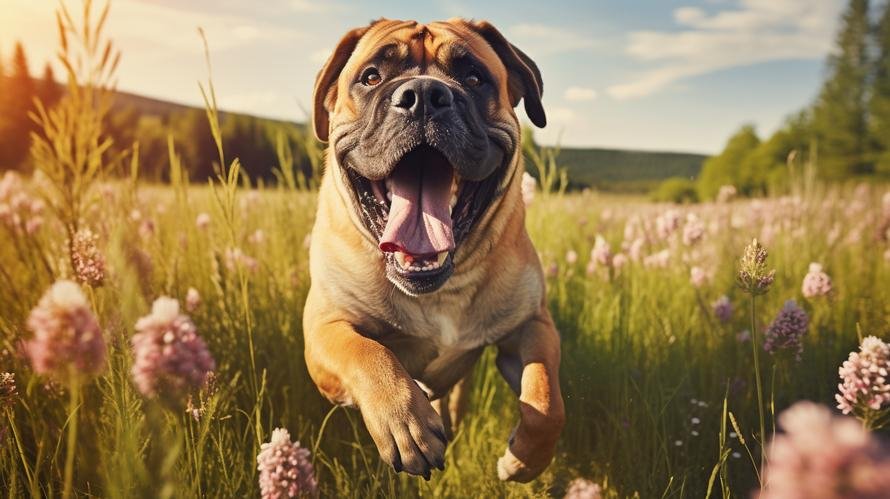English Mastiffs are a breed of dogs known for their towering presence and formidable size. You’ve probably seen their pictures, massive bodies cloaked in a coat of fawn, apricot, or brindle, sparks of intelligence twinkling in their expressive eyes. With their enormous size, it’s not surprising that many people may see them as intimidating, even going as far as to label them as dangerous.
But is that really accurate? Is a Mastiff a dangerous dog? Or is the perception rooted in misunderstanding and general fear of big dogs? Join us as we explore this large, gentle breed and uncover the truth behind the misconceptions.
While it’s true that Mastiffs are physically capable of inflicting harm due to their size and power, it’s essential to note that a dog’s behavior is highly influenced by its upbringing and environment. Astonishingly, despite their beast-like appearance, Mastiffs are known to be gentle, loyal, and incredibly affectionate. They are often referred to as “gentle giants”.
One of the oldest dog breeds, Mastiffs have a rich history dating back to 3000 BC. Their ancestors were used for hunting, guarding, and even war due to their strength. However, through centuries of selective breeding, modern Mastiffs have retained their sheer size but lost much of their aggressive instincts.
Instead, English Mastiffs, or simply Mastiffs, are nowadays celebrated for their patience and friendliness. They are excellent with children and have a deeply ingrained protective instinct towards their family. Think of them as a large, fluffy, and immensely powerful nanny, who will watch over your kids and keep unwanted elements away.
Indeed, an untrained or unsocialized Mastiff can indeed present challenges due to their size. A large dog might knock over a toddler or an elderly person unintentionally. However, labeling them as ‘dangerous’ because of their size is far too simplistic and overlooks the underlying issue of responsible pet ownership and proper training.
Training any dog, regardless of breed, is crucial. This is especially true for large breeds like Mastiffs. These dogs need to be taught basic manners and commands like ‘sit’, ‘stay’, and ‘leave it’ from a very young age. Socializing them early with other dogs and humans can also help reduce fearful or aggressive behaviors as they mature.
Mastiffs have a friendly disposition and are known to get along well with other pets too. Even cats! Yes, they are larger in size and could potentially be an accidental threat, but with the right training, you can minimize these risks substantially.
Regular exercise and mental stimulation are also essential for these dogs to be able to live a healthy and happy life. Mastiffs love to play and have a moderate energy level. This means they need regular walks and play sessions, along with plenty of toys and puzzles to keep their minds active. These activities not only provide a great bonding opportunity but also instill discipline and obedience.
While Mastiffs are generally healthy, they can suffer from certain breed-specific health issues like hip and elbow dysplasia, heart conditions, and certain cancers. Regular vet check-ups can help diagnose and treat these issues promptly.
Having a Mastiff as a part of your family is not just about managing a potentially large-sized pooch. It means accepting a dog breed with a heart as large as them, providing them with ample love, guidance, care and accepting the same, several times over, in return.
To call a Mastiff “dangerous” is a gross oversimplification. Any dog, regardless of breed, can be dangerous if not properly raised, trained, and cared for. So, if you find yourself falling under the charms of these large yet gentle dogs, don’t let the misconceptions scare you away.
The magic key to coexisting harmoniously with a Mastiff, or indeed, any dog breed is responsible ownership. Ensure they have a balanced diet, regular exercise, consistent training, and lots of love. After all, they are man’s best friend, and a Mastiff, with its large heart and protective instincts, can be one of the best friends you have ever had.
As with any major decision, getting a Mastiff should be carefully considered. They need space to move around and can be quite the couch potatoes indoors. They also have a large appetite to match their size. But most importantly, they require your time, dedication, and love.
Can a Mastiff be a dangerous dog? In the wrong hands, it could be possible. But are they inherently dangerous? Absolutely not! Remember, it’s not about the breed, but the deed. With responsible pet ownership and appropriate training, a Mastiff can be a loving, loyal, and protective family member.
Should the Mastiff’s size be a deterrent for you? Definitely not! Rather, let their size remind you of the amount of love they can shower upon you. Amid their giant structure resides a heart that is capable of immense love and joy. If you can genuinely appreciate that, you’re ready to welcome a Mastiff into your family with open arms!



